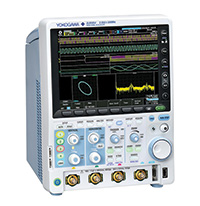Mixed signal oscilloscope
11/04/2019
The new Yokogawa DLM3000 is the first of a new generation of mixed-signal oscilloscopes featuring the familiar ‘look and feel’ and small footprint of the earlier DLM2000 series, but with a complete hardware redesign featuring higher measurement speed and precision plus an intuitive touch-screen display for enhanced ease of use and improved productivity. The DLM3000 builds on Yokogawa’s oscilloscope legacy, with new features focusing on quality, flexibility and usability to increase users’ productivity and meet the advanced needs of today’s designs, particularly in the mechatronics and automotive sectors. Integrating the latest in touch-screen operation, solid-state storage and high-speed signal processing, the DLM3000 enhances productivity by providing ‘clean’ noise-free signals, extensive processing and ease of
The DLM3000 builds on Yokogawa’s oscilloscope legacy, with new features focusing on quality, flexibility and usability to increase users’ productivity and meet the advanced needs of today’s designs, particularly in the mechatronics and automotive sectors. Integrating the latest in touch-screen operation, solid-state storage and high-speed signal processing, the DLM3000 enhances productivity by providing ‘clean’ noise-free signals, extensive processing and ease of operation.
The new instrument has a bandwidth of up to 500 MHz and a high sampling rate of 2.5 GS/s, making it ideally suited to precision waveform analysis in measurements on fast switching signals in inverter drives, for example. The high sample rate is combined with an on-board memory capacity of 250 megapoints and an increased voltage range, leading to lower residual noise and increased sensitivity. The DLM3000 also incorporates a variety of real-time low-pass filters to ensure the fidelity of captured signals.
The combination of the interactive touch-screen interface with a traditional oscilloscope control panel allows users to seamlessly transition between the two modes of operation, while a variety of communication and storage options make it easy to access large datasets.
In the multi-channel mixed-signal capability of the DLM3000 series, four channels of analogue input signals are converted to 8-bit logic, so that the instrument functions as a three-channel analogue oscilloscope combined with an 8-bit logic analyser. As a result, up to 11 input signals can be observed simultaneously as three channels of analogue signals and an 8-bit logic input.This means that the instrument can be used not only for the observation of data and control signals or as a trigger source, but also for the logic input analysis of I2C, SPI or other serial buses, removing the limitations imposed by the four channels of a standard oscilloscope in applications where the functioning of multi-channel digital control circuits needs to be examined.
The channel count and memory depth options combined with optional power maths and serial bus features, including major automotive buses, result in an oscilloscope that can be configured for a variety of needs.
The ‘best-in-class’ memory capacity of up to 500 megapoints allows the instrument to maintain its high sample rate in long-term measurements. A zoom and search function allows the user to select and display two zoomed waveforms with different time axis scales at the same time, searching captured waveforms in the large memory and displaying waveforms that meet a wide range of search criteria in the zoom area.
The powerful history memory function automatically saves up to 100,000 previously captured waveforms in the acquisition memory and subsequently displays just one or all of them on screen. The user can then perform cursor measurement, computation and other operations on history waveforms, allowing rarely occurring abnormal signals to be analysed.
The DLM3000 series comes with a variety of easy-to-configure triggers combining analogue and logic inputs such as edge, enhanced and B triggers.
Also included is a real-time filter with optimum noise reduction supporting a wide range of frequencies, from 8 kHz to 200 MHz. The DLM3000 series has two types of filter, one processed at the input circuit and one based on mathematical functions. These filters are effective for rejecting unwanted signals, allowing observation of only the desired bandwidths.
A range of functions that help operational efficiency include display trends of peak-to-peak or pulse width values per cycle, automatic measurement of voltage and time differences, analysis of frequency spectra, single-push snapshot of waveforms, display of stored waveforms in thumbnail format, ‘go/no-go’ function and checking functions with graphical online help.
Dedicated serial analysis function options (/F01 to /F05) are available for embedded systems and in-vehicle bus signals, along with decode display analysis. The logic input can also be used for specific serial buses, including UART, I2C, SPI and SENT. Complicated trigger and decode settings, such as bit rate and threshold level, are automatically detected. Simultaneous analyses of four different buses can be carried out, with waveforms and analysis results from buses with different speeds being displayed using dual zoom windows.
Dedicated power supply analysis options are available (in four-channel models only) for measuring switching loss, Joule integral (I2t), safe operating area (SOA) analysis, harmonic analysis of power supply current, based on EN 61000-3-2, and other power parameter measurements, such as active power and power factor. Utilising the large memory capability, voltage and current waveforms over long cycles can be input for computation of switching loss. Values can then be statistically processed and calculated.
A wide range of interfaces and software are available to provide broad connectivity and easier control. The DLM3000 is equipped with Gigabit Ethernet and USB 3.0 as standard communication interfaces to provide smoother linkages with PC applications.
The DLM3000 features an 8.4" capacitive touch-screen and is housed in a compact package with a portrait format that is approximately two-thirds the size of an A4 sheet of paper (with a depth of approximately 200 mm), to save space on the desk or test-bench.
www.yokogawa.com